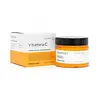What's inside
What's inside
 Key Ingredients
Key Ingredients

 Benefits
Benefits

 Concerns
Concerns

No concerns
 Ingredients Side-by-side
Ingredients Side-by-side

Water
Skin ConditioningGlycerin
HumectantPropanediol
SolventOryza Sativa Bran Oil
EmollientCetyl Alcohol
EmollientStearyl Stearate
EmollientCaprylic/Capric Triglyceride
MaskingGlyceryl Stearate
EmollientBetaine
HumectantCitrus Aurantium Dulcis Fruit Water
MaskingAscorbyl Methylsilanol Pectinate
AntioxidantSodium Allantoin PCA
Skin ConditioningSodium PCA
HumectantGlutamic Acid
HumectantGlycine
BufferingSerine
MaskingAlanine
MaskingArginine
MaskingLysine Hcl
Skin ConditioningProline
Skin ConditioningThreonine
Undaria Pinnatifida Extract
Skin ConditioningEnteromorpha Compressa Extract
Skin ProtectingPorphyra Umbilicalis Extract
Skin ConditioningLithothamnion Calcareum Extract
Skin ConditioningFucus Vesiculosus Extract
EmollientTocopherol
AntioxidantCrambe Abyssinica Seed Oil Phytosterol Esters
EmulsifyingRhus Verniciflua Peel Wax
Sodium Lactate
BufferingSodium Phytate
Ethylhexylglycerin
Skin ConditioningCeteth-20
CleansingSteareth-20
CleansingSodium Acrylates Crosspolymer-2
AbsorbentMethylpropanediol
SolventPEG-75 Stearate
Caprylyl Glycol
EmollientSodium Benzoate
MaskingPotassium Sorbate
PreservativePhenoxyethanol
PreservativeWater, Glycerin, Propanediol, Oryza Sativa Bran Oil, Cetyl Alcohol, Stearyl Stearate, Caprylic/Capric Triglyceride, Glyceryl Stearate, Betaine, Citrus Aurantium Dulcis Fruit Water, Ascorbyl Methylsilanol Pectinate, Sodium Allantoin PCA, Sodium PCA, Glutamic Acid, Glycine, Serine, Alanine, Arginine, Lysine Hcl, Proline, Threonine, Undaria Pinnatifida Extract, Enteromorpha Compressa Extract, Porphyra Umbilicalis Extract, Lithothamnion Calcareum Extract, Fucus Vesiculosus Extract, Tocopherol, Crambe Abyssinica Seed Oil Phytosterol Esters, Rhus Verniciflua Peel Wax, Sodium Lactate, Sodium Phytate, Ethylhexylglycerin, Ceteth-20, Steareth-20, Sodium Acrylates Crosspolymer-2, Methylpropanediol, PEG-75 Stearate, Caprylyl Glycol, Sodium Benzoate, Potassium Sorbate, Phenoxyethanol
Water
Skin ConditioningPropylene Glycol
HumectantAscorbic Acid
AntioxidantGlycerin
HumectantVitis Vinifera Seed Oil
EmollientDimethicone
EmollientXanthan Gum
EmulsifyingPolyacrylamide
C13-14 Isoparaffin
EmollientSodium Benzoate
MaskingPotassium Sorbate
PreservativeLaureth-7
EmulsifyingCitrus Aurantium Dulcis Peel Oil
MaskingLimonene
PerfumingSodium Hydroxide
BufferingCitral
PerfumingLinalool
PerfumingCI 77891
Cosmetic Colorant
 Reviews
Reviews

Ingredients Explained
These ingredients are found in both products.
Ingredients higher up in an ingredient list are typically present in a larger amount.
Glycerin is already naturally found in your skin. It helps moisturize and protect your skin.
A study from 2016 found glycerin to be more effective as a humectant than AHAs and hyaluronic acid.
As a humectant, it helps the skin stay hydrated by pulling moisture to your skin. The low molecular weight of glycerin allows it to pull moisture into the deeper layers of your skin.
Hydrated skin improves your skin barrier; Your skin barrier helps protect against irritants and bacteria.
Glycerin has also been found to have antimicrobial and antiviral properties. Due to these properties, glycerin is often used in wound and burn treatments.
In cosmetics, glycerin is usually derived from plants such as soybean or palm. However, it can also be sourced from animals, such as tallow or animal fat.
This ingredient is organic, colorless, odorless, and non-toxic.
Glycerin is the name for this ingredient in American English. British English uses Glycerol/Glycerine.
Learn more about GlycerinPotassium Sorbate is a preservative used to prevent yeast and mold in products. It is commonly found in both cosmetic and food products.
This ingredient comes from potassium salt derived from sorbic acid. Sorbic acid is a natural antibiotic and effective against fungus.
Both potassium sorbate and sorbic acid can be found in baked goods, cheeses, dried meats, dried fruit, ice cream, pickles, wine, yogurt, and more.
You'll often find this ingredient used with other preservatives.
Learn more about Potassium SorbateSodium Benzoate is a preservative. It's used in both cosmetic and food products to inhibit the growth of mold and bacteria. It is typically produced synthetically.
Both the US FDA and EU Health Committee have approved the use of sodium benzoate. In the US, levels of 0.1% (of the total product) are allowed.
Sodium benzoate works as a preservative by inhibiting the growth of bacteria inside of cells. It prevents the cell from fermenting a type of sugar using an enzyme called phosphofructokinase.
It is the salt of benzoic acid. Foods containing sodium benzoate include soda, salad dressings, condiments, fruit juices, wines, and snack foods.
Studies for using ascorbic acid and sodium benzoate in cosmetics are lacking, especially in skincare routines with multiple steps.
We always recommend speaking with a professional, such as a dermatologist, if you have any concerns.
Learn more about Sodium BenzoateWater. It's the most common cosmetic ingredient of all. You'll usually see it at the top of ingredient lists, meaning that it makes up the largest part of the product.
So why is it so popular? Water most often acts as a solvent - this means that it helps dissolve other ingredients into the formulation.
You'll also recognize water as that liquid we all need to stay alive. If you see this, drink a glass of water. Stay hydrated!
Learn more about Water